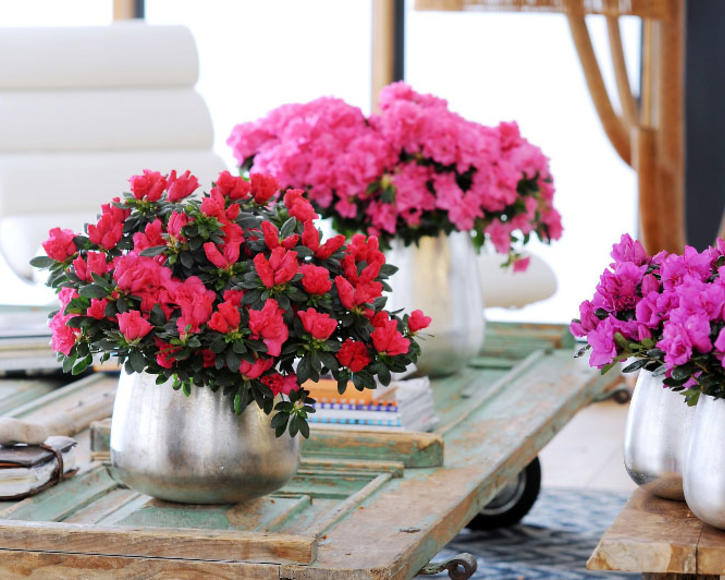Indoor Azalea
Indoor azaleas bring color into any home in winter with their range of varieties and plentiful flowers. With the right care, you will be able to enjoy these houseplants for a long time to come.
Factsheet
- Growth type
-
- Small shrub
- Growth height (from)
- from 15 cm to 100 cm
- Growth width (from)
- from 20 cm to 50 cm
- Growth characteristics
-
- spherical
- upright
- bushy
- Flower color
-
- red
- pink
- white
- Flowering time (month)
-
- January to March
- October to December
- Flower shape
-
- corymbus grapes
- simply
- filled
- Funnel
- Leaf color
-
- green
- page format
-
- elliptiques
- full margined
- Sheet properties
-
- evergreen
- Light
-
- semi-shade
- Soil Moisture
-
- moderately humid
- ph value
-
- weakly acidic
- Lime compatibility
-
- sensitive to lime
- Nutrient requirements
-
- moderately nutritious
- Humus
-
- rich in humus
- Decorative or utility value
-
- Flower Decoration
- Toxicity
-
- weakly poisonous
- Winter Hardness
-
- frost-sensitive
- Use
-
- high-stem
- Interior greening
- Planters
- Garden style
-
- Pot garden
Winter-flowering indoor azaleas are part of the heather family (Ericaceae) and belong botanically to the rhododendrons, which we so dearly love in our gardens thanks to their colorful and plentiful blooms in May. The indoor azalea originally comes from China and Japan, and was introduced to Europe in 1810. Cultivation has led to the development of many splendid varieties that all come from the Rhododendron simsii. Today, well over a hundred azalea varieties are available to buy with some not just suitable for indoor growing but also able to thrive in a garden.
Indoor azaleas are small, densely branched shrubs with dark green, leathery evergreen leaves. The green twigs are covered with bristly brownish hairs, as are the leaf stalks and calyxes. Depending on the variety, indoor azaleas bloom in shades of pink, red and purple from October to around May. There are single, double, large-flowered and small-flowered varieties that can grow up to between 5.90 and 39 inches tall.

Indoor azaleas thrive in their natural habitat of cool, damp soil. Even though newer varieties tolerate warmer locations, placing a pot in a warm living room is not ideal. If you have purchased azaleas - usually already flowering - they should not be placed in a warm room right away. Instead, let the azalea acclimate to the higher temperature gradually. Put it in a semi-shaded location with a temperature of 50 to 54 degrees Fahrenheit for two to three days. You can then bring the plants into a warmer room. If flowers are already fully developed, they may even tolerate rooms up to 68 degrees Fahrenheit. Do not place the plant on a windowsill above a heater, as the heated air will quickly cause the flowers to wilt.
Dead heads can be removed along with the stems. After flowering, you can support the indoor azalea’s stalks and cut the plant into shape. From mid May, you can plant them out in the garden in a location with partial shade and loose, humus-rich soil. In fall, the azaleas must be moved back to a cool place indoors until the buds swell and they are able to tolerate slightly warmer temperatures.

Azaleas should always be kept moist. But the root balls will not tolerate waterlogging. To avoid this, you can dunk the whole ball into water every four days. The water should ideally be boiled and cooled in advance to ensure your indoor azaleas get lime-free water. You should reduce watering in fall, as the first buds form.
Feed your indoor azaleas around every four weeks from spring to fall – so when the plant is not flowering – using a special rhododendron and azalea feed. There’s no need to feed during the flowering period in winter. Azaleas can be repotted every two years. As a substrate, you should use rhododendron soil with a pH between 3.5 and 4.5.
Indoor azaleas are propagated using semi-woody cuttings taken in early spring. Propagation is considered difficult, and not every cutting will become a strong plant. The cutting should be between 3.15 and 3.94 inches long. Eventually, all the leaves are removed up to the upper wreath of leaves and the azalea cuttings are planted in substrate, leaving 1.57 to 1.97 inches between each plant. It’s best to use a Styrofoam box with a layer of un-watered propagation substrate around 5.91 inches deep. A mixture of 2/3 sand and 1/3 peat has proven useful here.
After planting, spray the plants with water and cover the box with plastic wrap. This increases the humidity so the plants can form roots more easily. In the first two to three weeks, you should keep the cuttings in a relatively cool place (around 60 degrees Fahrenheit is optimal). The temperature can then be increased to around 68 degrees but the new location should not have full direct sunlight. You should ideally check that the temperature is right and that the substrate is sufficiently moist on a regular basis. New azaleas will have formed roots after six to eight weeks but should remain in the propagation box for a few more weeks before being potted on individually.
Most of the diseases affecting azaleas are due to incorrect handling and care, such as waterlogging and subsequent root rot. Spider mites also appear if the root ball is too dry. There are special canola oil-based products to combat this. Dark-winged fungus gnats like to settle on plant soil if the plants are kept too moist for a long period of time.

